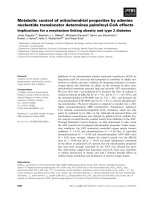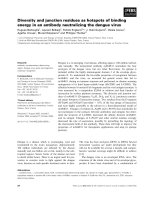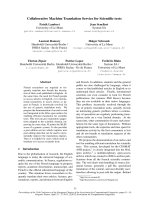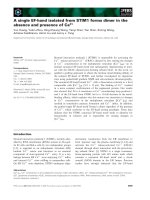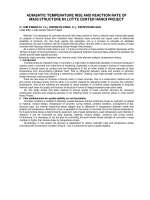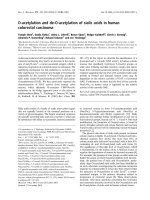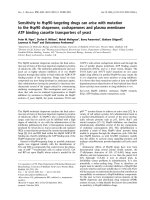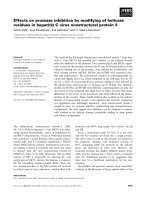Báo cáo khoa học: "Collaborative control initiatives targeting zoonotic agents of alveolar echinococcosis in the northern hemisphere" ppsx
Bạn đang xem bản rút gọn của tài liệu. Xem và tải ngay bản đầy đủ của tài liệu tại đây (1.62 MB, 9 trang )
JOURNAL OF
Veterinary
Science
Review
J. Vet. Sci. (2007), 8(4), 313
321
*Corresponding author
Tel: +81-11-388-4909; Fax: +81-11-388-4909
E-mail:
Collaborative control initiatives targeting zoonotic agents of alveolar
echinococcosis in the northern hemisphere
Masao Kamiya
*
OIE Reference Laboratory for Echinococcosis and Laboratory of Environmental Zoology, Department of Biosphere and
Environmental Sciences, Faculty of Environmental Systems, Rakuno Gakuen University, Hokkaido 069-8501, Japan
Alveolar echinococcosis is one of the most important le-
thal zoonotic helminth infections in the northern hemi-
sphere. Currently, the threat to public health is increasing,
as evidenced by the rising prevalence rate of alveolar echi-
nococcosis, as well as the invasion of urban areas by in-
fected wild foxes. This threat is further increased due to
the involvement of pet dogs, and probably cats, as emerg-
ing sources of infection. These increased threats to public
health also have associated economic risks; therefore,
there is a need for effective and sustainable methods of
control. In this paper, initiatives to control alveolar echi-
nococcosis by targeting its definitive hosts through an-
thelmintic baiting campaigns initiated by local residents
who used local resources for bait production, distribution
and collection of fecal samples for diagnosis are described.
Further, when such distribution programs are coupled
with the use of GIS-based maps, the optimum distribution
of bait was obtained. These programs have also included
the use of intravital diagnostic analyses of infection rates,
which have been overseen by the Forum on Environment
and Animals (FEA), and also allowed a nationwide mon-
itoring of echinococcosis in difinitive hosts. In addition, a
government initiative requiring mandatory reporting of
echinococcosis in dogs to health authorities was recently
initiated in Japan. Overall, the results of this study have
shown that use of collaborative control initiatives target-
ing zoonotic agents of alveolar echinococcosis can be an ef-
fective method for reducing the threat of lethal echino-
coccosis in the northern hemisphere.
Key words: alveolar echinococcosis, anthelmintic baiting, endo-
genous development, northern hemisphere, zoonosis
Introduction
Alveolar echinococcosis is caused by Echinococcus mul-
tilocularis, which is a zoonotic tapeworm parasite of can-
ids that is commonly distributed in the northern hemi-
sphere (Fig. 1). The occurrence of the causative cestode in
Japan is restricted to the northern island of Hokkaido, al-
though sporadic cases of human infections have been re-
ported on other islands [8]. Currently, this parasite is re-
ported to be distributed throughout the island of Hokkaido.
In addition, alveolar echinococcosis also occurs at low
rates in central and eastern Europe [6]. However, recent
studies of foxes in Europe have shown that E. multi-
locularis is more widespread than previously thought, be-
ing found as far south as Italy [25], as far north Lithuania
and Estonia [27] and as far as east as Turkey [17]. The dis-
ease is also prevalent in Russia and the newly independent
nations that were formerly part of the USSR, as well as
China and Mongolia [38,44,45]. Echinococcus multi-
locularis has also been reported in North America, and is
specifically found in the north central states and Alaska in
the US as well as in parts of Canada [4,16,39].
As of 2004, 482 patients in Hokkaido, Japan were con-
firmed to have been infected with alveolar echinococcosis,
and one study found that the rate of occurrence during the
endemic period was 48 cases per 100,000 residents every
year [31]. In addition, more than 76 cases were reported
from other islands [9], with most of these cases occurring
in the northern part of the mainland of Japan. In addition to
the cases reported in Japan, data from the European
Echinococcosis Registry (EurEchinoReg: 1982-2000)
[23] indicate that autochthonous cases of alveolar echino-
coccosis occurred in Austria (53 cases), Belgium (3 cases),
France (235 cases), Germany (126 cases), Greece (1 case),
and Switzerland (112 cases), and that 15 non-autoch-
thonous cases were recorded from several European coun-
tries, imported especially from central Asia. In addition, 14
cases were reported in Poland, which was previously not
314 Masao Kamiya
Fig. 1. The approximate geographic distribution of Echinococcus multilocularis in the northern hemisphere.
considered to be endemic for alveolar echinococcosis [44],
but were noted with increasing frequency since 1994 [29].
Because there is a long period between the time at which
infection with alveolar echinococcosis occurs and the de-
velopment of clinical disease, the recent increase in preva-
lence rates of infection in vectors may forecast higher prev-
alence rates in humans. A retrospective study of the disease
in Switzerland that covered 50 years concluded that the in-
cidence of human alveolar echinococcosis in that region
appears to be increasing, and that this increase was pre-
ceded 10 years earlier by a parallel increase in the infection
and urbanization of the fox population [37]. Humans be-
come infected after ingestion of the echinococcus eggs
from sources contaminated with feces from infected defin-
itive hosts, such as foxes, dogs, and occasionally cats.
However, general precautionary measures, such as avoid-
ance of drinking water from springs or rivers, washing of
hands and avoidance of contact with foxes has had no sig-
nificant effect in suppressing alveolar echinococcosis in
humans.
Human alveolar echinococcosis, although relatively rare
and generally considered an accidental spill-over from
wildlife, is one of the most difficult invasive helminthic in-
fections to diagnose, effectively treat and effectively eval-
uate during the post-treatment period [3]. The disease is
characterized by hepatic and sometimes cerebral disorders
caused by the larval form (metacestode) of the tapeworm.
The metacestode cells of E. multilocularis proliferate in a
fashion similar to tumor cells, and by the time clinical signs
are manifested, it is very difficult to treat, however, if no
treatment is provided the disease is lethal. In addition, the
disease can only be completely cured if confirmatory diag-
nosis is conducted during the early stages of the disease
and is followed by complete resection of all of the lesions
caused by the disease.
In addition to its adverse effects on human health, an epi-
demic of this disease could adversely affect the local econ-
omy of Japan due to its potential impact on agricultural and
tourist industries [24]. Therefore, this disease warrants im-
mediate attention and decisive action for its effective and
sustainable control. To accomplish this, it has been sug-
gested that public health authorities establish a coordinated
system of continuous surveillance and risk assessment, and
that these measures be combined with measures to reduce
illness and death that occurs as a result of alveolar echino-
coccosis in the human population [10]. To date, the most
effective control program encountered has been one that
was introduced by the OIE Reference laboratory for
Echinococcosis in Japan, which involves elimination of E.
multilocularis in its definitive hosts through deworming
[19]. The success of this program in Japan indicates that it
could also be successful in other endemic countries.
Hokkaido, Japan
Collaborative control initiatives targeting zoonotic agents of alveolar echinococcosis 315
Fig. 2. Prevalence rates of Echinococcus multilocularis infectio
n
in wild foxes in Hokkaido island from 1980 to 2002 (necropsy
survey data from the Hokkaido Government).
Sources of infection
Wild red foxes
The prevalence rate of E. multilocularis in wild foxes has
dramatically increased over the past few decades [30] (Fig.
2). In 1985, less than 10% of foxes were reportedly in-
fected, however, by 1998 this figure had risen to 58.4%,
and it has continued to increase over the past few years.
Due to the high prevalence rate of echinococcosis in wild
red foxes, as well as their increasing population, they are
considered to be the major definitive hosts of the parasite in
Japan [32]. Although most of the parasite biomass occurs
in foxes, other definitive hosts may also serve as sources of
infection [35], however, a mathematical model of egg ex-
cretion dynamics has suggested that foxes have a higher
mean biotic potential than any other known definitive hosts
[22].
In addition to the high prevalence rate of echinococcosis
in wild red foxes, the invasion of red foxes into urban areas
has also been of concern because it indicates that an in-
creasing infection pressure for densely populated areas is
inevitable. For these reasons, it is expected that an urban
cycle of E. multilocularis will eventually occur in the most
populous city of Hokkaido, Sapporo, and most surveys
conducted within the city, either by necropsy or cop-
roantigen detection, have already registered the presence
of Echinococcus-infected foxes in parks and woodlands
[43]. Further, large amounts of E. multilocularis cop-
roantigen positive fox feces have also been reported in ur-
ban areas adjacent to recreational parks [43]. Other suitable
intermediate hosts have also been trapped in recreational
parks, however none of these were found to be infected
[43]. This phenomenon has also been documented in other
endemic countries in which an increasing number of in-
fected foxes have been found foraging in cities and villages
[7]. For example, in Europe, prevalence rates in foxes have
risen in many agricultural dominated areas in France, The
Netherlands, Germany, Austria, Slovakia and Poland,
however, the life cycle has also been established in many
urban areas in which foxes are present in high population
densities, which presents an increased risk of infection for
large human populations [4,35].
In Japan, raccoon dogs have also been found to be in-
fected with E. multilocularis [48]. Based on experimental
infection studies they were suggested to be capable of play-
ing a significant role in the epidemiology of alveolar echi-
nococcosis [41]. Although their low population in
Hokkaido indicates that they may have a lesser role in
transmission of the disease, raccoon dogs have a greater re-
production potential than foxes, and their impact may in-
crease with the effects of global warming [41].
Domestic pets
Prevalence studies of echinococcosis in dogs in Japan
have been very limited; however, a 30 year survey by nec-
ropsy examinations of 9,930 dogs from 1966 conducted by
the Hokkaido government revealed 98 infected dogs.
Recently, annual examinations of less than 10 dogs con-
ducted by the Hokkaido government registered zero in-
cidence rate. However, the Forum on Environment and
Animals (FEA), from April 2004 through August 2005, ex-
amined a total of 1,460 fecal samples obtained from do-
mestic dogs nationwide by animal clinics found 4 (0.27%)
dogs that were positive for echinococcosis based on cop-
roantigen and PCR assays [18]. It was estimated that near-
ly ten thousand pet dogs are transported between Honshu
and Hokkaido by plane and ferry every year, and that this
includes up to 30 E. multilocularis-infected animals [8].
Further, it has been reported that 2 out of 69 dogs that were
moved from Hokkaido to Honshu were found to be pos-
itive for E. multilocularis based on coproantigen examina-
tion [21]. This has raised concerns that echinococcosis
might spread to Honshu as a result of pet dog translocation.
In addition, a dog in Saitama prefecture on the main island
(adjacent to Tokyo) was found to have E. multilocularis
eggs in its feces [47].
Additionally, a recent survey of dogs transported through
ferry ports in Hokkaido found 2 dogs (2/183) that were
positive for E. multilocularis coproantigen [28], and one of
these dogs was a non-resident of Hokkaido that had been
permitted to roam freely for only a few hours during its 5
day stay. Taken together, these findings suggest that there
has been a rise in the infection rate of domestic dogs in
Hokkaido, and that these dogs have the potential to spread
the disease throughout Japan. It should be noted, however,
that infection in domestic dogs can only be spread by way
of highly contaminated rodent intermediate hosts, which
are closely associated with the high infection prevalence
rates observed in wild foxes [12]. Nevertheless, it has been
demonstrated that dogs have a high biotic potential and
316 Masao Kamiya
Fig. 3. Manufacture of baits using local resources such as the fish-waste products. Baits are fortified with praziquantel.
contribution to the transmission cycle of echinococcosis
[22], and the lifetime incidence in dogs being infected with
E. multilocularis at least once can reach about 10% even in
a population that has only a low prevalence rate of in-
fection [7].
Echinococcosis infection in cats has also been reported,
however, in all cases the tapeworms collected were im-
mature in form [46], therefore, it has been suggested that
cats only play a minor role in the maintenance of E. multi-
locularis in endemic areas [41]. In spite of this, in Japan a
cat was recently shown to be excreting taeniid eggs that
were confirmed to be E. multilocularis by PCR. This recent
finding is similar to observations in Europe, which indicate
that cats are potential sources of infective eggs.
Control strategies against echinococcosis
Anthelmintic baiting
Rausch et al. [33] conducted the first study on anthel-
mintic treatment in a 10-year trial involving monthly de-
worming of dogs with praziquantel in a village in St. Law-
rence, Alaska a hyperendemic area to E. multilocularis.
Although discontinued recently because of the cost of the
drug, the replacement of sled-dogs by machines decreased
remarkably the incidence of alveolar echinococcosis in the
island. However, with the presence of other definitive
hosts, i.e. arctic foxes, different dimensions of the problem
are expected to surface.
It has since been asserted that there is no reliable, cost-ef-
fective method for the sustainable control or eradication of
E. multilocularis in the sylvatic cycle [10]. In spite of this
assertion, our reference laboratory has been deworming
red foxes in Koshimizu (200 km
2
), Hokkaido, Japan since
1997. To accomplish this, a survey was initially conducted
to locate fox dens, and then fox feces were collected from
the vicinity of the dens and examined for the presence of
taeniid eggs and Echinococcus coproantigen. The follow-
ing year, anthelmintic-fortified bait, which consisted of
commercial fish sausages (1.5 cm long) embedded with
one half of a 25 mg praziquantel tablet (Droncit; Bayer,
Germany), was distributed manually in approximately half
of the total area around the fox dens on a monthly basis on
foot. The baiting trial showed that there was a decrease in
the taeniid egg infection rate in foxes in the baited area after
one month, and that this suppressive effect persisted in the
following years, despite a decrease in the number of times
the bait was distributed. The trial also showed that inter-
mediate host rodents born following the bait distribution
had a significantly lower prevalence of infection than the
overwintered older rodents [42].
In a follow-up study conducted in April 2001, prazi-
quantel-fortified bait was distributed throughout the entire
area of Koshimizu alongside roads, at intersections and at
wind-shield forests by local residents using cars to allow
for faster mobility. The bait was made from fish-waste
products, using the same procedure that is used for manu-
facturing “kamaboko” (Fig. 3) fortified with praziquantel
(50 mg/ piece of bait). Based on a comparison of feces col-
lected from foxes within the treatment area to feces col-
lected from foxes outside the treatment area, which were
used as a control, taeniid egg infection rates and cop-
roantigen infection rates were significantly decreased in
foxes inside the treatment area. This significant reduction
of taeniid egg infection rates, however, was not observed
until six months after the start of bait distribution, and the
lower coproantigen positive rates were not observed for al-
most a year. A recent study found that, after continuous an-
nual distribution of bait manufactured from fish-waste
products the prevalence rate of coproantigen positive feces
in 2006 was reduced to zero. In this study, local residents
used cars to distribute bait annually alongside roads, at in-
tersections between roads, and in wind-shield forests, and
this proved to be a rapid method that did not require a large
number of personnel and was highly effective at suppress-
ing the infection rate of E. multilocularis in wild red foxes
[19].
A control strategy initiated by local residents was also
conducted in Kutchan, Hokkaido, Japan, which is another
Collaborative control initiatives targeting zoonotic agents of alveolar echinococcosis 317
echinococcosis endemic area. A baseline study, in which
fox feces were collected from a 100 km
2
study area, was
conducted in July, September and November of 2005, prior
to the distribution of bait. The prevalence rates of taeniid
egg and E. multilocularis coproantigen positive feces were
7% (19/268) and 21% (55/268), respectively. Between
May and November of 2006, a monthly distribution of ap-
proximately 1,500 pieces of bait was conducted through-
out the study area by volunteers comprised of local resi-
dents of Kutchan. The bait was distributed with the use of
GIS- based maps to identify the foraging habitat of wild
foxes. Remarkably, the prevalence rates of taeniid egg and
coproantigen positive feces dropped to 0% and 2% after
less than a year of baiting. The results obtained when this
strategy was used indicate that distribution of prazi-
quantel-fortified bait using GIS-based maps could allow
bait distribution to be restricted to only areas commonly
visited by foxes, thereby cutting costs and time.
The baiting system implemented in Japan varies from that
of Germany, which started wild fox deworming in 1990.
Although the vegetation, quantity of snowfall, the species
of voles involved and their habitat in Hokkaido are differ-
ent from those of Europe, the primary difference in baiting
systems used is that the post-deworming prevalence rates
of infection in Europe are evaluated by hunting the foxes.
In a baiting campaign that utilized planes to distribute bait
over a large area, stronger effects were observed in the 156
km
2
core area than in the 6 to 10 km border area. It has been
suggested that the border effect observed in this campaign
may have occurred as a result of immigration of young, in-
fected foxes [14,36]. Similarly, following control trials in
northern Germany, the prevalence rate of infection recov-
ered unexpectedly and rapidly, reaching pre-control levels
15 months after the end of the baiting campaign [13]. It is
believed that this occurred as a result of young foxes being
dispersed due to hunting pressure upon foxes in the border
area, which resulted in there being vacant territories avail-
able for younger generations of infected foxes. While some
studies have indicated that there were no significant
age-dependent differences in the rate of E. multilocularis
infection, other studies have found juvenile foxes to be
more frequently infected than adults, and infection rates in
young foxes have been found to be significantly greater un-
der highly-endemic conditions than low-endemic con-
ditions [11,40]. In addition, it has been reported that sub-
adult foxes carry significantly higher worm burdens than
adult foxes [15]. Taken together, these findings indicate
that invasion of young infected foxes into the territories left
by the hunted foxes could maintain or increase the preva-
lence rate of infection.
In Japan, however, the ecological niches of the foxes be-
ing treated were not disturbed because the efficacy of de-
worming was assessed using coproantigen detection in fox
feces collected from the environment of baited areas in-
stead of hunting. The differences observed in the efficacy
of the Japanese treatment method and the German method
indicate that the use of fox culling or hunting for evaluation
of control efficacy is actually detrimental to the success of
the baiting campaign [20]. Similarly, anthelmintic baiting
of foxes against urban contamination with E. mutilocularis
using intravital diagnosis for the assessment of efficacy
was highly successful in Switzerland [14]. In the Swiss
study, a pronounced reduction of E. multilocularis preva-
lence rates was observed in both the definitive and inter-
mediate hosts when an approach combining anthelmintic
baiting and coproantigen diagnosis was used.
Taken together, these results indicate that the use of intra-
vital diagnosis, such as coproantigen [1] or copro-DNA
[26] examination provides a superior means for assessing
control interventions while preserving both the animals be-
ing treated and their environments.
The role of local residents in treatment initiatives
“Endogenous development” involves building on local
resources, enhancing in situ development, maximizing lo-
cal control of the development process, and recognizing
the needs and the values of local residents [34]. As the Dag
Hammarskjӧld Report [5] puts it, such development relies
on what a human group has: its natural environment, its
cultural heritage, the creativity of the men and women who
constitute it, becoming richer through exchange between
them and with other groups and entails the autonomous
definition of development styles and of life styles.
In all of the baiting campaigns reviewed in this paper that
were conducted in Japan, the endogenous initiative of local
residents, which was facilitated by NonProfit Organization
(NPO), was highly instrumental. Zoonotic diseases are of
concern not only to public health personnel but also to in-
dividual residents who are at risk of infection. Moreover,
the use of local resources, including local residents for fe-
cal collection and bait distribution, locally produced
fish-waste products for bait manufacturing, and local
fund-raising to support the deworming program was found
to be imperative for the success of a sustainable program
for the control and prevention of echinoccocosis.
In a follow-up campaign that has been ongoing in
Koshimizu since 2002, bait distribution, fecal collection
and monitoring of echinococcosis in wild foxes was con-
ducted by Okhotsk Sanctuary, a local NPO. Endogenous
control initiatives introduced by this NPO provided a nec-
essary solution that allowed the prolongation of the baiting
campaign, thereby enabling a sustainable approach to the
suppression of the E. multilocularis infection in wild red
foxes, as indicated by the most recent prevalence rate of
coproantigen positive feces of wild foxes in Koshimizu,
which was 0%.
Another control initiative introduced by another NPO
such as WAO in Kutchan, Hokkaido [31] also produced fa-
318 Masao Kamiya
vorable results. To finance a long term preventive measure,
WAO organized an echinococcosis control sticker sale
campaign, in which stickers containing information re-
garding the life cycle of E. multilocularis and the threat of
echinococcosis to public health are sold at approximately
US $ 4. The proceeds of the sticker sales are then used to fi-
nance the program, including the costs of the anthel-
mintic-fortified baits and fecal examinations. In addition,
WAO, with the help of the OIE reference lab, spearheaded
an information dissemination initiative that involved local
residents, including university students and children in ele-
mentary school.
National government initiatives
The results of our research project, entitled “Prevention
on the spread of areas that are endemic for zoonotic para-
sitic diseases” disclosed a strong possibility that dogs in-
fected with Echinococcus could transmit the infection to
their owners. Based on these findings, the Ministry of
Health, Labor and Science, Japan directed the Hokkaido
Prefectural Government to take measures to prevent the in-
fection of pet owners from occurring, including campaigns
to make the public aware of the potential threat [19].
In addition, an amendment to the Infectious Disease Law
in Japan was made that required inclusion of certain specif-
ic zoonotic diseases in the 4th category (diseases which
must be reported). The diseases added to this category in-
cluded echinococcosis in dogs as well as bacterial dysen-
tery in primates and West Nile fever in birds. In addition,
during their 20th session, the Infectious Disease Evalua-
tion Committee of the Ministry of Health, Labor, and
Science passed a resolution that made it mandatory for vet-
erinarians to report cases of echinococcosis in dogs to the
health authorities. Thus, a national reporting system for
dogs infected with E. multilocularis has been used by vet-
erinarians since October 2004 [19].
The Ministry of Health, Labor, and Science, with the as-
sistance of our laboratory, has also published guidelines re-
garding standard procedures and diagnostic measures to be
taken when reports are submitted by veterinarians, and
these guidelines have been distributed to local health offi-
ces, as well as to practicing veterinarians throughout Japan.
The following three criteria for diagnosis are stipulated in
the national reporting system, and a positive result in any of
these should be reported to health authorities [19,30]:
a) locating a parasite body that can be morphologically
identified
b) detecting parasite DNA in eggs or a part of a parasite
body
c) detecting parasite coproantigen, which should become
negative after deworming.
Research laboratory initiatives
It is believed that research institutions have an important
role to play in extending practical assistance to the public
as the knowledge and understanding of the disease ad-
vances, especially with regards to its control and preven-
tion. Thus, according to Zinsstag [49] “Although there is
no doubt that progress in animal health research must con-
tinue, it must also respond to societal needs and lead to sol-
utions that can be delivered quickly.” Therefore, in 1999,
this OIE reference laboratory organized a scheme called
the FEA, Japan. This scheme is able to link important or-
ganizations including government offices, academic in-
stitutions, international agencies (e.g. the OIE), veterinary
associations and non-governmental organizations, such as
NPOs comprised of local residents, that all have the pri-
mary goal of controlling echinococcosis in Hokkaido.
The FEA is presently serving as a hub for private veter-
inarians involved in small animal practice throughout
Japan for the confirmatory diagnosis of echinococcosis.
Veterinarians who suspect Echinococcus infection in dogs,
cats, or other susceptible definitive hosts send fecal sam-
ples to the FEA, which then conducts laboratory
examinations. Further, the FEA has assisted with the en-
dogenous initiative of NPOs by providing them with tech-
nical expertise, laboratory examinations of fox feces, an-
thelmintic-fortified baits and necessary materials such as
the “eki-bin” (echi-bottle), which are containers used for
the collection of fecal samples safely. In addition, the FEA
provides intravital diagnosis using ELISA (EmA9) to de-
termine the prevalence rate of echinococcosis in foxes dur-
ing pre- and post-baiting campaigns. Overall, the FEA has
enhanced the connection between laboratory findings and
field applications through accurate diagnosis and proper
monitoring of echinococcosis in Japan.
Recently, “Full-Echinococcus”, a database of full-length
cDNAs obtained from a human parasite, E. multilocularis,
was produced in cooperation with this reference labora-
tory. The full-length cDNA library was produced using the
Vector-trapper method on hydatid cysts developed in cot-
ton rats that were infected with E.multilocularis. A total of
10,966 5'end-one-pass sequences were compared with the
non-redundant database, DDBJ/Genbank/EMBL, using
the BLAST and TBLASTX programs. Two-thirds of the
sequences were considered to be derived from Echinococ-
cus, while the remaining one-third represented host genes.
Many of the former clones represent full-length cDNAs
that are expressed in the larval stage, and these clones are
available for further analysis and experiments.
Conclusions
The increasing prevalence rates of red foxes infected with
the parasite, E. multilocularis, in the northern hemisphere
represent a public health threat. In addition, it is feared that
the invasion of infected foxes into urban areas and the pro-
portional increase in infection pressure upon pet dogs may
Collaborative control initiatives targeting zoonotic agents of alveolar echinococcosis 319
cause an epidemic in these endemic areas and disperse the
infection to neighboring non-endemic areas. Ultimately,
echinococcosis, which is endemic in the northern island of
Japan, may spread into the mainland.
Because there is still no vaccine available for echino-
coccosis, the best means for control at present is deworm-
ing the definitive hosts, especially foxes, which produce
the greatest biomass of the zoonotic agent. Baiting cam-
paigns conducted in Hokkaido have been found to be very
effective at reducing the prevalence rates of infection in
wild foxes, and praziquantel-fortified bait distribution us-
ing cars to deliver the bait to strategic locations identified
by GIS-based maps was found to be a valuable method for
reducing costs and saving time. Complementing this, the
OIE Reference Laboratory and FEA strongly advocate the
use of intravital techniques for assessment of the efficacy
of deworming trials to avoid the recurrence of high preva-
lence rates of infection due to immigration of young in-
fected foxes into territories left by culled foxes, as well as
to preserve environmental animals and their ecology.
These control programs may also be applied in other en-
demic areas in the northern hemisphere to avoid dispersion
of zoonotic agents. In addition, collaborative efforts ini-
tiated by local residents herein referred as “endogenous de-
velopment” may be a significant and sustainable approach
in the control of other vector borne zoonotic diseases such
as found in the rest of the world.
The initiative of local NPOs, coupled with the aid of this
reference laboratory was successful at facilitating control
of echinococcosis. The establishment of the FEA, which is
currently helping to protect the public health and regional
economy of the northern island of Japan from alveolar
echinococcosis, strengthened this collaborative inititia-
tives. In addition, the national initiative put forth by the
government requiring mandatory reporting of echino-
coccosis in dogs has also strengthened public health safety
protection and welfare. It is recommended, however, that
the Ministry of Environment and the Ministry of Agricul-
ture take part in the collaborative efforts to help ensure suc-
cessful control of alveolar echinococcosis in Japan.
Overall, this collaborative initiative revealed the dynamic
and essential roles of local residents, the national govern-
ment and our research laboratory in seeking out potential
and optimum means of controlling diseases that are of pub-
lic health and veterinary importance. This model is also ap-
plicable for developed and developing countries that desire
a safer society and a cleaner environment.
Acknowledgments
I especially thank Dr. Yuzaburo Oku, Center of Exce-
llence (COE), Hokkaido University, for providing the bulk
of the data for this paper and Dr. Nariaki Nonaka,
Hokkaido University, for his data on pet dogs, Dr. Jose
Trinipil Lagapa, Central Mindanao University, Philippi-
nes, for the helpful assistance, and Dr. Sumiya Ganzorig
and Mr. Fumio Kobayashi of the FEA for their invaluable
support to this control program. I also wish to convey my
deep gratitude to the international researchers who have
cooperated with us in conceptualizing this control pro-
gram: Dr. Bruno Gottstein of The University of Bern,
Switzerland; Dr. Robert L. Rausch of The University of
Washington, USA; Dr. Dominique Vuitton of The Univer-
sity of Franche-Comte, France; Dr. Jun Watanabe of the
University of Tokyo, Japan; and Dr. Hee-Jeong Youn of
Seoul National University, Korea. Special recognition to
the NPO's of Koshimizu and Kutchan towns of Hokkaido,
Japan.
References
1. Allan JC, Craig PS. Coproantigens in taeniasis and
echinococcosis. Parasitol Int 2006, 55, S75-80.
2. Bru
ž
inskait
ė
R, Marcinkut
ė
A, Strupas K, Sokolovas V,
Deplazes P, Mathis A, Eddi C,
Š
ark
ū
nas M. Alveolar echi-
noccoccosis, Lithuania. Emerg Infect Dis 2007, 13, 1618-
1619
3. Craig PS. Epidemiology of echinococcosis in western
China. In: Torgerson PR, Shaikenov BS (eds.). Echinococco-
sis in Central Asia: Problems and Solution. pp. 43-58,
Publishing House Dauir, Almaty, 2004.
4. Craig PS. Echinococcus multilocularis. Curr Opin Infect Dis
2003, 16, 437-444.
5. Dag Hammarskj
ӧ
ld Foundation. The 1975 Dag Hammar-
skj
ӧ
ld Report on Development and International Coope-
rations. p. 28. Dag Hammarskj
ӧ
ld Foundation, Uppsala,
Sweden, 1982
6. Deplazes P. Ecology and epidemiology of Echinococcus
multilocularis in Europe. Parassitologia 2006, 48, 37-39.
7. Deplazes P, Hegglin D, Gloor S, Romig T. Wilderness in
the city: the urbanization of Echinococcus multilocularis.
Trends Parasitol 2004, 20, 77-84.
8. Doi R, Matsuda H, Uchida A, Kanda E, Kamiya H, Konno
K, Tamashiro H, Nonaka N, Oku Y, Kamiya M.
Possibility of invasion of Echinococcus into Honshu with pet
dogs from Hokkaido and overseas. Nippon Koshu Eisei
Zasshi 2003, 50, 639-649.
9. Doi R, Nakao M, Nihei N, Kutsumi H. Epidemiology of al-
veolar hydatid disease (AHD) and estimation of infected pe-
riod of AHD on Rebun Island, Hokkaido. Nippon Koshu
Eisei Zasshi 2000, 47, 145-152.
10. Eckert J, Deplazes P. Biological, epidemiological, and clin-
ical aspects of echinococcosis, a zoonosis of increasing
concern. Clin Microbiol Rev 2004, 17, 107-135.
11. Ewald D, Eckert J, Gottstein B, Straub M, Nigg H.
Parasitological and serological studies on the prevalence of
Echinococcus multilocularis Leuckart, 1863 in red foxes
(Vulpes vulpes Linnaeus, 1758) in Switzerland. Rev Sci Tech
1992, 11, 1057-1061.
12. Gottstein B, Saucy F, Deplazes P, Reichen J, Demierre G,
Busato A, Zuercher C, Pugin P. Is high prevalence of
320 Masao Kamiya
Echinococcus multilocularis in wild and domestic animals
associated with disease incidence in humans? Emerg Infect
Dis 2001, 7, 408-412.
13. Hansen F, Tackmann K, Jeltsch F, Wissel C, Thulke HH.
Controlling Echinococcus multilocularis-ecological implica-
tions of field trials. Prev Vet Med 2003, 60, 91-105.
14. Hegglin D, Ward PI, Deplazes P. Anthelmintic baiting of
foxes against urban contamination with Echinococcus
multilocularis. Emerg Infect Dis 2003, 9, 1266-1272.
15. Hofer S, Gloor S, Muller U, Mathis A, Hegglin D,
Deplazes P. High prevalence of Echinococcus multilocularis
in urban red foxes (Vulpes vulpes) and voles (Arvicola ter-
restris) in the city of Zurich, Switzerland. Parasitology 2000,
120, 135-142.
16. Holt DW, Hanns C, O'Hara T, Burek K, Frantz R. New
distribution records of Echinococcus multilocularis in the
brown lemming from Barrow, Alaska, USA. J Wildl Dis
2005, 41, 257-259.
17. Inceboz T, Korkmaz M, Tokat Y, Uner A. The first report
of Echinococcus multilocularis strain isolation from human
in Turkey. Turkiye Parazitol Derg 2005, 29, 31-33.
18. Kamiya M, Lagapa JT, Ganzorig S, Kobayashi F, Nonaka
N, Oku Y. Echinococcosis risk among domestic definitive
hosts, Japan. Emerg Infect Dis 2007, 13, 346-347.
19. Kamiya M, Lagapa JT, Nonaka N, Ganzorig S, Oku Y,
Kamiya H. Current control strategies targeting sources of
echinococcosis in Japan. Rev Sci Tech 2006, 25, 1055-1065.
20. Kamiya M, Lagapa JT, Oku Y. Research on targeting sour-
ces of alveolar echinococcosis in Japan. Comp Immunol
Microbiol Infect Dis 2007, 30, 427-448.
21. Kamiya M, Nonaka N, Ganzorig S, Oku Y. Effective coun-
termeasures against alveolar echinococcosis in the red fox
population of Hokkaido, Japan. In: Torgerson PR, Shaikenov
BS (eds.). Echinococcosis in Central Asia: Problems and
Solutions. pp. 273-282, Publishing House Dauir, Almaty,
2004.
22. Kapel CM, Torgerson PR, Thompson RC, Deplazes P.
Reproductive potential of Echinococcus multilocularis in ex-
perimentally infected foxes, dogs, raccoon dogs and cats. Int
J Parasitol 2006, 36, 79-86.
23. Kern P, Bardonnet K, Renner E, Auer H, Pawlowski Z,
Ammann RW, Vuitton DA, Kern P. European Echinococ-
cosis Registry. European echinococcosis registry: human al-
veolar echinococcosis, Europe, 1982-2000.
Emerg Infect
Dis 2003, 9, 343-349.
24. Konno K, Oku Y, Tamashiro H. Prevention of alveolar
echinococcosis-ecosystem and risk management perspec-
tives in Japan. Acta Trop 2003, 89, 33-40.
25. Manfredi MT, Casulli A, La Rosa G, Di Cerbo AR,
Trevisio K, Genchi C, Pozio E.
Echinococcus multilocu-
laris in north Italy. Parasitologia 2006, 48, 43-46.
26. Mathis A, Deplazes P. Copro-DNA tests for diagnosis of ani-
mal taeniid cestodes. Parasitol Int 2006, 55, S87-90.
27. Moks E, Saarma U, Valdmann H. Echinococcus multi-
locularis in Estonia. Emerg Infect Dis 2005, 11, 1973-1974.
28. Morishima Y, Sugiyama H, Arakawa K, Kawanaka M.
Echinococcus multilocularis in dogs, Japan. Emerg Infect
Dis 2006, 12, 1292-1294.
29. Myjak P, Nahorski W, Pietkiewicz H, von Nickisch-
Rosenegk M, Stolarczyk J, Kacprzak E, Felczak-
Korzybska I, Szostakowska B, Lucius R. Molecular con-
firmation of human alveolar echinococcosis in Poland. Clin
Infect Dis 2003, 37, 121-125.
30. Nonaka N, Kamiya M, Oku Y. Towards the control of
Echinococcus multilocularis in the definitive host in Japan.
Parasitol Int 2006, 55, S263-S266.
31. Oku Y. Expansion of the distribution of Echinococcus multi-
locularis which propagates and spreads in the human body. J
Modern Vet Med 2000, 48, 5-17.
32. Oku Y, Kamiya M. Biology of Echinococcus. In: Otsuru M,
Kamegai S, Hayashi S (eds.). Progress of Medical Parasitol-
ogy in Japan. Vol. 8. pp. 293-318, Meguro Parasitological
Museum, Tokyo, 2003.
33. Rausch RL, Wilson JF, Schantz PM. A programme to re-
duce the risk of infection by Echinococcus multilocularis: the
use of praziquantel to control the cestode in a village in the
hyperendemic region of Alaska. Ann Trop Med Parasitol
1990, 84, 239-250.
34. Rist A. Endogenous development as a social learning
process. Compas Magazine 2004, 7, 26-29.
35. Romig T, Dinkel A, Mackenstedt U. The present situation
of echinococcosis in Europe. Parasitol Int 2006, 55, S187-
191.
36. Schelling U, Frank W, Will R, Romig T, Lucius R.
Chemotherapy with praziquantel has the potential to reduce
the prevalence of Echinococcus multilocularis in wild foxes
(Vulpes vulpes). Ann Trop Med Parasitol 1997, 91, 179-186.
37. Schweiger A, Ammann RW, Candinas D, Clavien PA,
Eckert J, Gottstein B, Halkic N, Muellhaupt B, Prinz BM,
Reichen J, Tarr PE, Torgerson PR, Deplazes P. Human al-
veolar echinococcosis after fox population increase, Swit-
zerland. Emerg Infect Dis 2007, 13, 878-882.
38. Shaikenov BS. Distribution and ecology of Echinococcus
multilocularis in Central Asia. Parasitol Int 2006, 55, S213-
219.
39. Storandt ST, Virchow DR, Dryden MW, Hygnstrom SE,
Kazacos KR. Distribution and prevalence of Echinococcus
multilocularis in wild predators in Nebraska, Kansas, and
Wyoming. J Parasitol 2002, 88, 420-422.
40. Tackmann K, Loschner U, Mix H, Staubach C, Thulke
HH, Ziller M. Conraths FJ. A field study to control
Echinococcus multilocularis-infections of the red fox
(Vulpes vulpes) in an endemic focus. Epidemiol Infect 2001,
127, 577-587.
41. Thompson RC, Kapel CM, Hobbs RP, Deplazes P.
Comparative development of Echinococcus multilocularis in
its definitive hosts. Parasitology 2006, 132, 709-716.
42. Tsukada H, Hamazaki K, Ganzorig S, Iwaki T, Konno K,
Lagapa JT, Matsuo K, Ono A, Shimizu M, Sakai H,
Morishima Y, Nonaka N, Oku Y, Kamiya M. Potential
remedy against Echinococcus multilocularis in wild red fox-
es using baits with anthelmintic distributed around fox breed-
ing dens in Hokkaido, Japan. Parasitology 2002, 125, 119-
129.
43. Tsukada H, Morishima Y, Nonaka N, Oku Y, Kamiya M.
Preliminary study of the role of red foxes in Echinococcus
multilocularis transmission in the urban area of Sapporo,
Japan. Parasitology 2000, 120, 423-428.
Collaborative control initiatives targeting zoonotic agents of alveolar echinococcosis 321
44. Vuitton DA, Zhou H, Bresson-Hadni S, Wang Q, Piarroux
M, Raoul F, Giraudoux P. Epidemiology of alveolar echino-
coccosis with particular reference to China and Europe.
Parasitology 2003, 127, S87-107.
45. Wang Q, Vuitton DA, Qiu J, Giraudoux P, Xiao Y,
Schantz PM, Raoul F, Li T, Yang W, Craig PS. Fenced
pasture: a possible risk factor for human alveolar echino-
coccosis in Tibetan pastoralist communities of Sichuan,
China. Acta Trop 2004, 90, 285-93.
46. Yagi K, Takahashi K, Hattori K. A case of immature
Echinococcus multilocularis in a domestic cat in Nemuro,
eastern Hokkaido, Japan. Rep Hokkaido Inst Pub Health
1984, 34, 68-69.
47. Yamamoto N, Morishima Y, Kon M, Yamaguchi M,
Tanno S, Koyama M, Maeno N, Azuma H, Mizusawa H,
Kimura H, Sugiyama H, Arakawa K, Kawanaka M. The
first reported case of a dog infected with Echinococcus multi-
locularis in Saitama prefecture, Japan.
Jpn J Infect Dis 2006,
59, 351-352.
48. Yimam AE, Nonaka N, Oku Y, Kamiya M. Prevalence and
intensity of Echinococcus multilocularis in red foxes (Vulpes
vulpes schrencki) and raccoon dogs (Nyctereutes procyo-
noides albus) in Otaru City, Hokkaido, Japan. Jpn J Vet Res
2002, 49, 287-296.
49. Zinsstag J. Animal health research. Science 2007, 315, 1193.
